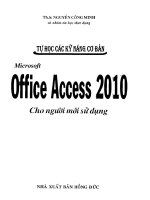Bài giảng Mạng máy tính nâng cao: Chapter 1 - Lê Ngọc Sơn
Bạn đang xem bản rút gọn của tài liệu. Xem và tải ngay bản đầy đủ của tài liệu tại đây (2.58 MB, 82 trang )
Chapter 1
Introduction
A note on the use of these ppt slides:
We’re making these slides freely available to all (faculty, students, readers).
They’re in PowerPoint form so you can add, modify, and delete slides
(including this one) and slide content to suit your needs. They obviously
represent a lot of work on our part. In return for use, we only ask the
following:
If you use these slides (e.g., in a class) in substantially unaltered form,
that you mention their source (after all, we’d like people to use our book!)
If you post any slides in substantially unaltered form on a www site, that
you note that they are adapted from (or perhaps identical to) our slides, and
note our copyright of this material.
Computer Networking:
A Top Down Approach ,
5th edition.
Jim Kurose, Keith Ross
Addison-Wesley, April
2009.
Thanks and enjoy! JFK/KWR
All material copyright 1996-2009
J.F Kurose and K.W. Ross, All Rights Reserved
CuuDuongThanCong.com
Introduction
/>
1-1
Chapter 1: Introduction
Our goal:
get “feel” and
terminology
more depth, detail
later in course
approach:
use Internet as
example
Overview:
what’s the Internet?
what’s a protocol?
network edge; hosts, access net,
physical media
network core: packet/circuit
switching, Internet structure
performance: loss, delay,
throughput
security
protocol layers, service models
history
Introduction
CuuDuongThanCong.com
/>
1-2
Chapter 1: roadmap
1.1 What is the Internet?
1.2 Network edge
end systems, access networks, links
1.3 Network core
circuit switching, packet switching, network structure
1.4 Delay, loss and throughput in packet-switched
networks
1.5 Protocol layers, service models
1.6 Networks under attack: security
1.7 History
Introduction
CuuDuongThanCong.com
/>
1-3
What’s the Internet: “nuts and bolts” view
PC
Hàng triệu thiết bị tính
toán được nối mạng:
server
wireless
laptop
cellular
handheld
access
points
wired
links
router
hosts = end systems
chạy các ứng dụng
mạng
communication links
fiber, copper,
radio, satellite
transmission
rate = bandwidth
routers: Chuyển các
packets (gói tin)
Mobile network
Global ISP
Home network
Regional ISP
Institutional network
Introduction
CuuDuongThanCong.com
/>
1-4
“Cool” internet appliances
Web-enabled toaster +
weather forecaster
IP picture frame
/>
World’s smallest web server
/>
Internet phones
Introduction
CuuDuongThanCong.com
/>
1-5
What’s the Internet: “nuts and bolts” view
protocols (giao thức) điều
Mobile network
khiển việc gửi/nhận các msg
Global ISP
e.g., TCP, IP, HTTP, Skype,
Ethernet
Internet: “mạng của các
mạng”
loosely hierarchical
public Internet versus private
intranet
Home network
Regional ISP
Institutional network
Các tiêu chuẩn Internet
RFC: Request for comments
IETF: Internet Engineering
Task Force
Introduction
CuuDuongThanCong.com
/>
1-6
What’s the Internet: a service view
Hạ tầng truyền thông
(communication
infrastructure) cho phép các
ứng dụng phân bố:
Web, VoIP, email, games,
e-commerce, file sharing
Các ứng dụng sử dụng các
dịch vụ truyền thông
(communication services)
Truyền dữ liệu bảo đảm từ
máy nguồn đến máy đích
Truyền dữ liệu thường (ko
bảo đảm)
Introduction
CuuDuongThanCong.com
/>
1-7
What’s a protocol?
human protocols:
“Mấy giờ rồi?”
“Cho tôi hỏi”
giới thiệu
… gửi đi một thông điệp
nhất định
… một hành động nhất
định được thực hiện
khi nhận được thông
điệp, hoặc khi có 1 sự
kiện khác
network protocols:
Máy tính, ko phải người
Tất cả các hoạt động
truyền thông trên
Internet phải tuân thủ
các protocols
protocols define format,
order of msgs sent and
received among network
entities, and actions
taken on msg
transmission, receipt
Introduction
CuuDuongThanCong.com
/>
1-8
What’s a protocol?
a human protocol and a computer network protocol:
Xin chào
TCP connection
request
Xin chào
Cho hỏi mấy giờ rồi?
TCP connection
response
Get />
2:00
<file>
Thời gian
Q: Other human protocols?
Introduction
CuuDuongThanCong.com
/>
1-9
Chapter 1: roadmap
1.1 What is the Internet?
1.2 Network edge
end systems, access networks, links
1.3 Network core
circuit switching, packet switching, network structure
1.4 Delay, loss and throughput in packet-switched
networks
1.5 Protocol layers, service models
1.6 Networks under attack: security
1.7 History
Introduction
CuuDuongThanCong.com
/>
1-10
A closer look at network structure:
network edge: ứng
dụng và các máy
tính (hosts)
access networks,
physical media:
wired, wireless
communication links
network core:
interconnected
routers
network of
networks
CuuDuongThanCong.com
Introduction
/>
1-11
The network edge:
end systems (hosts):
Chạy các C trình ứng dụng
e.g. Web, email
ở “đường biên của mạng” peer-peer
client/server model
Client yêu cầu và nhận các dịch
vụ từ các server
client/server
e.g. Web browser/server;
email client/server
peer-peer model:
Dùng ít hoặc ko dùng các
server dành riêng
e.g. Skype, BitTorrent
Introduction
CuuDuongThanCong.com
/>
1-12
Access networks and physical media
Q: Kết nối các host vào các
edge router ra sao?
Qua mạng truy cập thường
trực
Mạng truy cập của tổ chức
(trường học, cty)
Mạng truy cập không dây
Nhớ :
Khả năng truyền (bandwidth,
bits per second) của mạng
truy cập?
Dùng chung hay dành riêng?
Introduction
CuuDuongThanCong.com
/>
1-13
Dial-up Modem
Văn phòng trung tâm
telephone
network
Máy tính gia đình
home
dial-up
modem
Internet
ISP
modem
(e.g., AOL)
Sử dụng hạ tầng mạng điện thoại đang có
Máy tính gia đình được kết nối vào văn phòng
trung tâm
Tốc độ truy cập trực tiếp đến các router lên tới 56Kbps
Ko thể vừa lướt web, vừa nghe điện thoại cùng lúc
CuuDuongThanCong.com
/>
Digital Subscriber Line (DSL)
Existing phone line:
0-4KHz phone; 4-50KHz
upstream data; 50KHz-1MHz
downstream data
home
phone
Internet
DSLAM
telephone
network
splitter
DSL
modem
home
PC
central
office
Cũng sử dụng hạ tầng điện thoại đang có
Tốc độ upstream lên tới 1Mbps (hiện giờ < 256 Kbps)
Tốc độ downstream lên tới 8Mbps (hiện giờ < 1 Mbps)
Sử dụng đường truyền vật lý dành riêng nối đến văn
phòng trung tâm.
CuuDuongThanCong.com
/>
Residential access: cable modems
Không sử dụng hạ tầng điện thoại
Sử dụng hạ tầng mạng truyền hình cáp
HFC: hybrid fiber coax
Bất đối xứng: 30Mbps downstream, 2 Mbps
upstream
Mạng lưới cáp đồng và cáp quang nối từng hộ gia
đình đến router của ISP
Các hộ gia đình chia sẻ truy cập (share access)
tới router
Không như DSL, kỹ thuật dedicated access
Introduction
CuuDuongThanCong.com
/>
1-16
Residential access: cable modems
Diagram: />CuuDuongThanCong.com
Introduction
/>
1-17
Cable Network Architecture: Overview
Typically 500 to 5,000 homes
cable headend
cable distribution
network (simplified)
home
Introduction
CuuDuongThanCong.com
/>
1-18
Cable Network Architecture: Overview
server(s)
cable headend
cable distribution
network
home
Introduction
CuuDuongThanCong.com
/>
1-19
Cable Network Architecture: Overview
cable headend
cable distribution
network (simplified)
home
Introduction
CuuDuongThanCong.com
/>
1-20
Cable Network Architecture: Overview
FDM (more shortly):
V
I
D
E
O
V
I
D
E
O
V
I
D
E
O
V
I
D
E
O
V
I
D
E
O
V
I
D
E
O
D
A
T
A
D
A
T
A
C
O
N
T
R
O
L
1
2
3
4
5
6
7
8
9
Channels
cable headend
cable distribution
network
home
Introduction
CuuDuongThanCong.com
/>
1-21
Fiber to the Home
ONT
optical
fibers
Internet
OLT
ONT
optical
fiber
central office
optical
splitter
ONT
Sử dụng đường cáp quang nối đến nhà
Sử dụng 2 kỹ thuật cáp quang cạnh tranh:
Passive Optical network (PON)
Active Optical Network (PAN)
Tốc độ truy cập Internet cao hơn, cho phép TV và
điện thoại.
CuuDuongThanCong.com
/>
Ethernet Internet access
100 Mbps
Institutional
router
Ethernet
switch
To Institution’s
ISP
100 Mbps
1 Gbps
100 Mbps
server
Được dùng phổ biến trong các Cty, trường học, …
10 Mbs, 100Mbps, 1Gbps, 10Gbps Ethernet
Hiện thời, các host được nối trực tiếp đến các Ethernet
switch
CuuDuongThanCong.com
/>
Wireless access networks
Kết nối host đến router qua các
mạng truy cập không dây
(wireless) dùng chung
Qua các base station (hoặc “access
point”)
wireless LANs:
router
base
station
802.11b/g (WiFi): 11 or 54 Mbps
wider-area wireless access
provided by telco operator
~1Mbps over cellular system
(EVDO, HSDPA)
next up (?): WiMAX (10’s Mbps)
over wide area
mobile
hosts
Introduction
CuuDuongThanCong.com
/>
1-24
Home networks
Các thành phần tiêu biểu của home network
DSL or cable modem
router/firewall/NAT
Ethernet
wireless access
point
to/from
cable
headend
cable
modem
wireless
laptops
router/
firewall
Ethernet
wireless
access
point
Introduction
CuuDuongThanCong.com
/>
1-25









